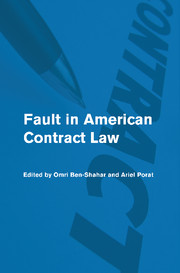Preface
Published online by Cambridge University Press: 10 November 2010
Summary
Introduction
The basic rule of liability in tort law is fault. The basic rule of liability in contract law is no fault. This is perhaps one of the most striking divides within private law, the most important difference between the law of voluntary and the law of nonvoluntary obligations. It is this fault line (speaking equivocally) that this book explores. Is it a real divide – two opposite branches of liability within private law – or is it merely a rhetorical myth? How can it be justified?
For law-and-economics scholars, this fault/no-fault divide between contract and tort is all the more puzzling. In law and economics, legal rules are understood as incentives, evaluated within a framework in which parties take actions to prevent different types of loss. Tortfeasors can take measures to avoid accidents; contracting parties can take measures to avoid loss from breach. The context of the loss can diverge between contract and tort – accidents to strangers versus harm to a known breached-against party – but the underlying framework of incentives is similar, if not identical. Robert Cooter famously described this underlying framework as a unified “model of precaution,” and Richard Craswell showed how to think of the breach-or-perform decision as a problem of precaution, mirroring the framework of tort law. Thus, to those who take the idea of a unified model seriously, a significant puzzle looms large: If these two branches of law share the same underlying framework, why do they follow different liability regimes?
Information
- Type
- Chapter
- Information
- Fault in American Contract Law , pp. xi - xxPublisher: Cambridge University PressPrint publication year: 2010
